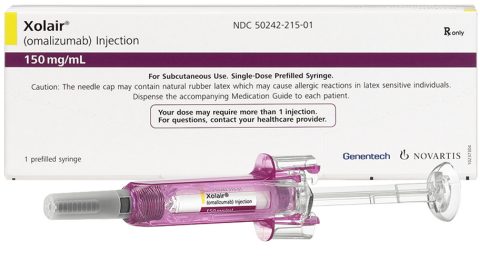There is no cure for food allergy, though there are newly emerging therapies that show promise. The best studied treatments involve immunotherapy or desensitization to a food allergen using different methods of delivery.
Treatment for individuals with multiple food allergies

In February 2024, the U.S. Food and Drug Administration (FDA) approved Xolair® (brand name for omalizumab) for food allergy as a treatment to reduce the risk of reactions to multiple foods. Xolair is a biologic given as an injection under the skin to help protect children and adults against accidental exposure to multiple foods. Patients who take Xolair must continue to avoid foods to which they are allergic.
About Xolair
What is Xolair and who can now use it as a food allergy treatment in the U.S.?
Xolair is a biologic medicine designed to target and block immunoglobulin E (IgE), the antibody that triggers allergic reactions. It is given as an injection under the skin every 2 or 4 weeks, and those taking it must continue to avoid their allergens. Once someone stops taking Xolair, the IgE is no longer blocked.
Over the past several years, this drug has been in a clinical trial, called OUtMATCH, to determine if it could be effective and safe as a therapy in patients with multiple food allergies. The trial included individuals between 1-55 years of age with allergy to peanut and at least two other trial-specified foods (cashew, milk, egg, walnut, wheat, and hazelnut). Findings revealed that the medication allowed them to tolerate higher amounts of such foods without causing major reactions.
Based on the trial results, the FDA has approved Xolair for use in certain adults and children for the reduction of allergic reactions that may occur with accidental exposure to one or more foods.
Why is this not available in Canada yet?
Novartis, who owns Xolair in Canada, needs to file for market access approval with Health Canada. We’ve reached out to Novartis to understand their plans. Additionally, work needs to be done to understand how the cost of this treatment will be covered. Currently in the U.S., the monthly costs range from $2,900/month for children to $5,000/month for adults.
Watch the webinar
Watch our April 2024 webinar: “What’s the big deal about Xolair®: What is it and how does it reduce allergic reactions to foods?”. With this session, you will hear from Dr. Sharon Chinthrajah, the senior investigator involved in the OUtMATCH clinical trial. Dr. Chinthrajah covers what Xolair is and how it works, who the target patient is for this medication, along with the objectives, treatment protocols and results of the OUtMATCH clinical trial.
You can also read our Q/As in addition to watching the webinar. These questions have been answered by Dr. Chinthrajah.
Food allergen immunotherapy

There are three major forms of food allergen immunotherapy:
- Oral immunotherapy: the allergen is eaten
- Sublingual immunotherapy: the allergen is placed under the tongue
- Epicutaneous immunotherapy: an allergen patch is applied to the skin
Oral immunotherapy
With oral immunotherapy (OIT), small amounts of a food allergen are given by mouth in gradually increasing doses until the patient is able to eat a certain amount of the food allergen without a reaction so long as they are on this treatment. Currently, OIT is not a mainstream practice in Canada and it is not universally covered by provincial health plans. It is mostly done in research settings and in some allergists’ practices.
Treatment approved in U.S. for peanut allergy
![PALFORZIA™ [Peanut (Arachis hypogaea) Allergen Powder-dnfp] Capsules](https://foodallergycanada.ca/wp-content/uploads/Aimmune_PALFORZIA_Capsule_Image_FDA_Approval_1-300x117.jpg)
In January 2020, the U.S FDA approved PALFORZIA™ (AR101) for treatment of patients with peanut allergy. PALFORZIA is a biologic medicine for peanut OIT for children 4-17 years of age. It comes in capsules, filled with a specific amount of peanut flour, which are opened and mixed into food that is eaten daily. While PALFORZIA is not offered in Canada, peanut OIT is being done by allergists in some clinic and hospital settings across Canada.
10 questions to ask your allergist about OIT
If you are considering OIT, below are some questions to ask your allergist to determine if OIT is right for you and your family:
- What is Oral Immunotherapy treatment? Is it effective?
- What is the process of OIT? Will there be an oral food challenge at the start?
- What training, resources and counselling will I receive to prepare for OIT, and during the OIT process? What are my responsibilities?
- What are the potential side effects?
- What happens if there’s sickness or travel during treatment?
- What if there’s a reaction in the office? At home?
- What result can I expect from the treatment?
- What are the risks versus the benefits of this treatment? What are the alternatives to OIT?
- Do I have to decide on therapy now or can I decide later?
- How much will it cost?
- Learn more about OIT
Watch our recorded webinar - Read our ask the allergist article on OIT
Sublingual immunotherapy
With sublingual immunotherapy (SLIT), small amounts of a food allergen are placed under the tongue and then swallowed or spit out. As with OIT, SLIT protocols include dose escalation and maintenance phases although the doses are typically smaller than those in OIT. SLIT is mostly done in research settings.
Epicutaneous immunotherapy
In epicutaneous immunotherapy (EPIT), a patch containing a food allergen is applied to the skin. Unlike OIT and SLIT, there’s a set amount of food allergen in the patch and it’s worn for an increasing number of hours per day. Once it’s worn for 24 hours per day, the patch is replaced daily. EPIT is currently done in research settings.
While OIT, SLIT and EPIT provide hope, they are a potential treatment for some patients with food allergy, but not all. The information about such emerging therapies can change. As always, speak with your doctor if you have any questions or concerns.
- An oral food challenge (OFC) is often done at the start of a treatment to confirm a patient’s food allergy and determine what amount of allergen they react to. An OFC may also be conducted during the course of a treatment to see how much more the patient can eat without having an allergic reaction.
- Learn more about OFC on our diagnosis page.
Desensitization, tolerance and sustained unresponsiveness

Food allergen immunotherapy can potentially result in three outcomes: a need to stop the treatment because of allergic symptoms, desensitization, or tolerance.
In most of the OIT studies and in reports from those providing OIT treatment currently, there are people who cannot continue taking the treatment. The number who cannot continue varies based on many factors. Overall it’s about 1 in 5 patients who cannot continue the treatment, sometimes it’s more than that and sometimes it’s less.
With desensitization, a patient can eat more of their food allergen without having a reaction, as long as they are taking routine doses of that food.
If tolerance is achieved, a patient can stop eating that particular food and then resume eating it, without having a reaction. We do not know if any person reaches true tolerance with OIT. For this reason, the term “sustained unresponsiveness” has been introduced to describe the ability of a patient to eat the food without having an allergic reaction after stopping OIT for a period of time (usually weeks).
Advocating for access to therapies
In the National Food Allergy Action Plan, the development and access to therapy options is one of the areas we are advocating for on your behalf. This includes advocating for access to OIT and future therapies to give you more choices in how to approach managing food allergy, while research for a cure continues.
Research
There are many clinical trials ongoing in food allergy which may be registered on clinicaltrials.gov. You can also check our participate in research page for additional studies.

